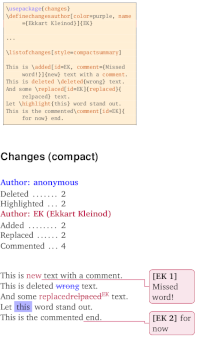The LaTeX changes package
Manual change markup
Before submitting an error, please refer to the issue tracker and the subpages if your error resp. problem is already known.
The LaTeX changes package
Auf dieser Seite
Overview
The changes-package allows the user to manually markup changes of text, such as additions, deletions, or replacements. Changed text is shown in a different color; deleted text is striked out. Additionally, text can be highlighted and/or commented. The package allows free definition of additional authors and their associated color. It also allows you to change the markup of changes, authors, highlights or comments.
The package is an official LaTeX package, i.e. it is available via CTAN and is included in the usual LaTeX distributions.
- CTAN
- Sourceforge
- Manuals
Markup
The package provides five commands for change markup and one for outputting a list of changes:
\added[id=<id>, comment=<comment>]{new text} \deleted[id=<id>, comment=<comment>]{deleted text} \replaced[id=<id>, comment=<comment>]{new text}{deleted text} \highlight[id=<id>, comment=<comment>]{highlighted text} \comment[id=<id>]{comment} \listofchanges[style=<style>, title=<tile>, show=<type>]
Moreover, there are package options, commands for adapting the layout or for the definition of authors, etc. They are described in detail in the user manual.
New Text
New text is marked up with added:
\added[id=<id>, comment=<comment>]{new text}
Examples:
This is \added{new} text. This is \added[comment=forgotten]{new} text. This is \added[id=EK]{new} text. This is \added[id=EK, comment={put it there}]{new} text.
Deleted Text
Deleted text is marked up with deleted:
\deleted[id=<id>, comment=<comment>]{deleted text}
Examples:
This is \deleted{bad} text. This is \deleted[comment=obsolete]{bad} text. This is \deleted[id=EK]{bad} text. This is \deleted[id=EK, comment={What did I think?}]{bad} text.
Replaced Text
Replaced text is marked up with replaced:
\replaced[id=<id>, comment=<comment>]{new text}{deleted text}
Examples:
This is \replaced{new}{old} text. This is \replaced[comment=meh]{new}{old} text. This is \replaced[id=EK]{new}{old} text. This is \replaced[id=EK, comment={sounds better}]{new}{old} text.
Highlighted Text
Highlighted text is marked up with highlight:
\highlight[id=<id>, comment=<comment>]{highlighted text}
Examples:
This is an \highlight{important} issue. This is an \highlight[comment=yess]{important} issue. This is an \highlight[id=EK]{important} issue. This is an \highlight[id=EK, comment={Because I say so!}]{important} issue.
Comments
Comments are marked up with comment:
\comment[id=<id>]{comment}
Examples:
This is a commented\highlight{This!} issue. This is a commented\highlight[id=EK]{Still unclear.} issue.
List Of Changes
The list of changes is printed with listofchanges:
\listofchanges[style=<style>, title=<title>, show=<type>]
Examples:
\listofchanges \listofchanges[style=summary] \listofchanges[title={My Changes}] \listofchanges[show=highlight|comment, title={Commented and highlighted}]
Errors, Wishes, Improvements
If you want to participate, be it with error messages, discussions, feature wishes, or programming, please use one of the following options:
- via email (see email symbol in the footer)
- via issue tracker
- via programming in gitlab using pull requests
